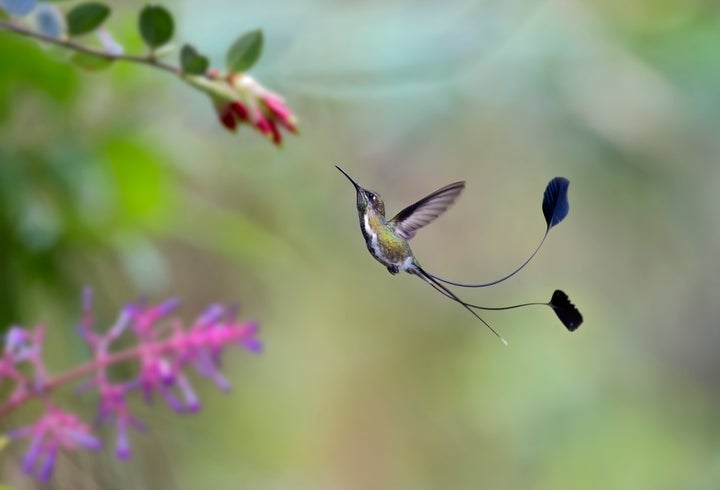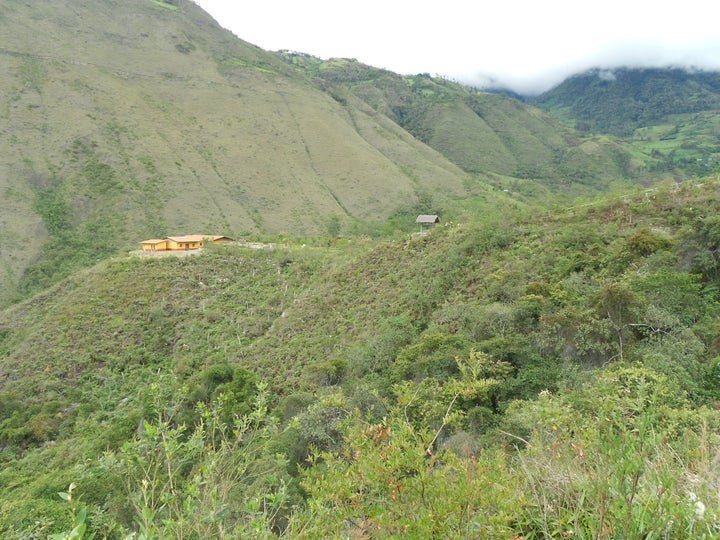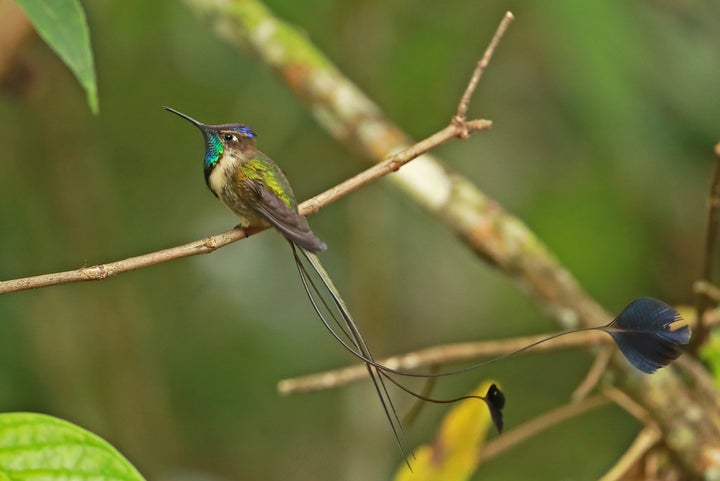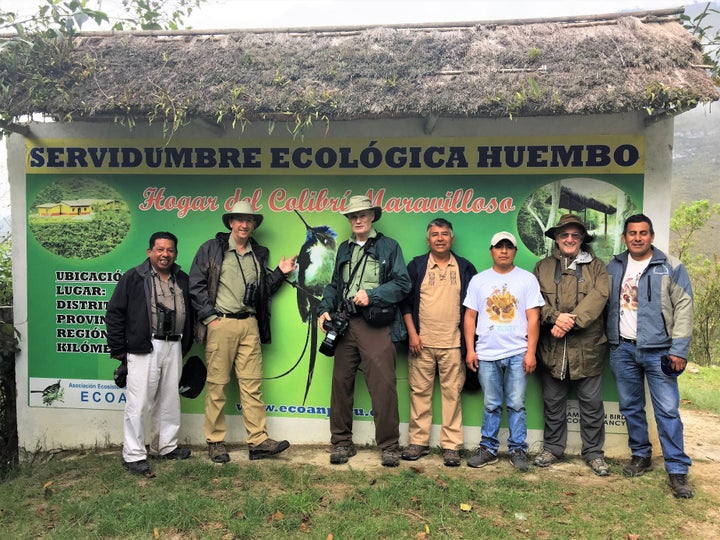The northern Peru birding route winds inland from the country’s arid Pacific coast, through lowland forests and scrubland dotted with cacti, over the Andes Mountains to the Utcubamba River valley. In a tiny patch of cloud forest, 7,000 feet up along the valley’s eastern slopes, lives the elusive marvelous spatuletail, perhaps the most spectacular hummingbird in the world, and one of the rarest.
Weighing as much as a pair of pennies and measuring 10 to 15 centimeters long, the male has a head crested in brilliant blue feathers, its throat a burst of iridescent turquoise. More than half the bird’s length is devoted to two extravagant tail feathers — slender appendages that splay dramatically outward and terminate in flashy violet disks, or spatules, like decorative fans.
Constantino Aucca, a longtime conservationist, has been guiding bird-watchers in Peru for more than 30 years. In the 1990s, he would often bring tourists to this remote area near the town of Pomacochas, the only place on Earth to catch a glimpse of the spatuletail hummingbird.

But he could see that the birds’ already limited habitat range (less than 3,400 square miles, by one estimate) was getting smaller. Many of the local people raised cattle and they would chop down or set fires to trees to make way for grazing, sometimes destroying 20 acres of forest for just one or two cows.
Fearing for the future of the endangered marvelous spatuletail, Aucca set out to convince the community to protect and revitalize their degraded mountain landscape. Now, 20 years later, the preservation scheme he created, the first of its kind in Peru, is a thriving example of how reforestation, improved agricultural practices, and a culture of conservation can protect habitat for wild animals while also benefiting the people who live among them.
“It serves as a model of what successful conservation looks like,” said Daniel Lebbin, vice president of threatened species at the American Bird Conservancy.
“When Constantino Aucca first proposed the idea of a nature reserve in the area, people laughed at him, asking why he wanted to protect land that wouldn’t even grow grass. 'I came for one bird,' he told them.”
Autumn is migration season for birds in North America. Some, like the Canada warbler, have flown thousands of miles to winter in the towering alders of the Andean forests around Pomacochas. These trees weren’t here when Aucca was leading birding trips a few decades ago. Now, standing 50 feet tall and bustling with avian life, they are a testament to the work of Aucca and the Association of Andean Ecosystems (ECOAN), the conservation nonprofit he co-founded — along with ABC and other organizations — to establish a protected area and rehabilitate the weakened landscape.
When Aucca, who lives in the city of Cuzco, more than 900 miles from Pomacochas, first proposed the idea of a nature reserve in the area, in 2003, people there laughed at him, asking why he wanted to protect land that wouldn’t even grow grass.
“I came for one bird,” he told them.
The locals were skeptical. They didn’t believe anyone would attempt to regrow the blighted forest just for one tiny bird, or stick around long enough to do so.

At the time, Aucca said, international nongovernmental organizations lamented the way communities were destroying wildlife habitats, yet they resisted engaging those communities in their conservation efforts, seeing that as social work, not conservation.
Aucca disagreed. He thought it was vital to work with people who lived in the area, to get them invested, and to ensure they benefited as well.
Proponents of community-based conservation argue efforts to protect biodiversity are more successful when their goals align with those of the local people, and when those people are actively involved.
“It is a fundamental strategy for conservation to involve local people,” said Mariana Montoya, director of the Wildlife Conservation Society in Peru. “Conservation should be done that way — not just working with or for communities, conservation must be done by communities.”
Aucca asked the residents of Pomacochas what they wanted in exchange for letting him reserve a parcel of land for conservation, and they said trees that would provide shade for their cows.
He told them: “This will provide food, trees, money and happiness.”
It took time to gain the locals’ trust. To reforest the area, ECOAN set up a tree nursery nearby. At first, Aucca had to pay landowners to let him plant seedlings on their property. But local leaders, including a farmer named Santos Montenegro who was particularly adept at spotting spatuletails on his property, helped spread an understanding of why restoring and protecting the habitat was good not just for animals, but for the community — including improving pastureland and prohibiting development that could pollute watersheds.

Eventually, people came around to volunteer their land for reforesting. Between 2005 and 2006, ECOAN planted 11,000 native trees for the marvelous spatuletail and other species.
“We have to involve the community in the subject of conservation so that people stop habits that are bad for the environment, like burning the forests every year,” Montenegro told HuffPost.
Enlisting ABC as a partner and financial backer, in 2005 Aucca convinced the community and a private landowner to grant them an ecological easement — a form of legally recognized protection, and the first of its kind in Peru — on about 80 acres of land. It was there, years earlier, he saw the incredible sight of three male spatuletails dancing around a bush bursting with blue flowers. The community still owned the land but agreed to limit its use to conservation activities and allow ECOAN to establish the Huembo hummingbird reserve and a small lodge for visitors (with money from another organization). All tourism profits would be evenly distributed among community members. Aucca hired Montenegro and his family to manage the property.

For a long time, the marvelous spatuletail was difficult to find. Now, birding sites herald Huembo as a “paradise” for the endangered birds, where visitors can catch a glimpse of them, along with a dozen other hummingbird species, simply by sitting for an hour by the park’s bird feeders.
(Tourism doesn’t bring in as much money as they’d like — especially since the start of the pandemic — so Montenegro and ECOAN’s director of conservation and development, Adrian Torres, plan to start selling coffee Montenegro grows in a small shade plantation on the reserve. The packages will be emblazoned with an image of the marvelous spatuletail.)
ECOAN and the American Bird Conservancy are working to develop a comprehensive monitoring system to track the species’ numbers and to see how the birds are taking to the new forest growth. Huembo is tiny as reserves go (even with the addition of 17 acres in 2013), and though it doesn’t take much to provide for a bird the size of a pingpong ball with antennae, the reserve alone can’t protect the entire population, said ABC’s Lebbin.
What’s more important, he stressed, is that the culture of conservation has spread beyond the reserve’s boundaries — exemplifying what Robert Horwich, founder of the nonprofit Community Conservation, called “conservation contagion.”
“There are no other institutions doing this reforestation work. ECOAN keeps going, and the people are happy.”
- Santos Montenegro
“A big part of the success is changing the community’s relationship with the bird,” Lebbin said. “We’re seeing widespread awareness and care. Inside and outside of Huembo, people are planting species they know the bird feeds on.”
Conservation awareness has been spreading throughout Peru, Montoya said, with community initiatives to protect natural resources sprouting up over the last 20 years — many started by the communities themselves. Even very small projects can have important effects, creating networks of conservation, prompting new efforts in nearby communities, and acting as ecological “stepping stones” connecting disparate conservation areas.
“This is important because national protected areas or even regional protected areas really can’t conserve everything,” she explained. Vitally, she added, community and privately owned reserves are managed with and by local residents, and benefit their lives and livelihoods.

Montenegro said the people of Pomacochas are very happy with ECOAN’s tree nursery because it has enabled them to create living fences around their properties (saving the cost of building fences) and practice a silvopasture program, which combines managed forest and pastureland. That results in healthier soil, shade for grazing livestock, fruit and — after a decade or two of growth — timber that community members can use or sell. Some people are now growing vegetables among the alders, which enrich the soil with nitrogen.
“The people keep planting,” Montenegro said. “There are no other institutions doing this reforestation work. ECOAN keeps going, and the people are happy.”
Due in part to seeing the successful reforestation in Pomacochas, people around the region have asked ECOAN to help them designate land for ecological protection and revitalize natural habitats. The organization has planted 600,000 trees and bushes around Huembo and close to 1 million in other communities in northern Peru.
Torres — who sports a tattoo of the marvelous spatuletail on his right arm — is working with small community initiatives along the northern birding route to help them learn to manage their forests, set up feeders and run responsible ecotourism operations. He aims for the small stretch of road near Pomacochas to be known, one day, as the Hummingbird Route.
For more content and to be part of the “This New World” community, follow our Facebook page.